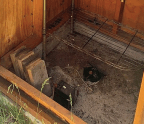
As in many countries, the United States’ food system has become dependent on multinational corporations that import food grown in faraway places. Since the early 2000s, food import costs have increased five times over — to a whopping $18 billion annually. Of course, pineapples and kiwis come from locales with warmer climates, but we also import produce that can easily be grown in the U.S., including tomatoes, blueberries, and bell peppers, even during summer months. Domestically sourced produce comes mostly from drought-stricken California, which supplies one-third of the remaining vegetables consumed in the U.S. and three-quarters of fruits and nuts—but ever more precariously, as evidenced by almond and avocado failures in recent years.
This over-reliance on imports wasn’t always the norm. During the early 1900s, nearly 40% of Americans still lived on farms, and most food was grown locally. To give an example: At the turn of the century, nearly all apples eaten in Iowa were grown in Iowa orchards (compared with only 15% today). The dramatic shift came after World War II, when Americans gained access to better refrigeration technology and a nationwide transportation network. By 2015, the proportion of food sales considered local had declined to 2%.
Are we destined for an import-reliant food system? A growing cadre of farmers who employ techniques collectively referred to as “controlled-environment






